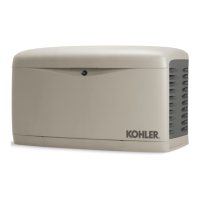TP-6735 7/1764 Section 5 Component Testing and Adjustment
5.5 Slip Rings
Slip rings acquire a glossy brown finish in normal
operation. Do not attempt to maintain a bright,
newly-machined appearance on the slip rings.
Cleaning with a dry, lint-free cloth is usually sufficient.
Use very fine sandpaper (#00) and apply light pressure
to remove roughness. Do not use emery or
carborundum paper or cloth. Clean all carbon dust from
the generator after sanding the slip rings. If the rings are
black or pitted, remove the rotor and use a lathe to
remove some of the s lip ring surface material.
5.6 Brushes
The brushes transfer current to the slip rings. The
brushes should last the life of the generator. However,
abrasive dust on the slip ring can shorten the life of the
brushes.
Excessive arcing at the brushes could damage the
controller. Weak springs, damaged slip rings, sticking
brushes, a loose brush holder, or poor brush contact
causes arcing.
The brush holder assemblies are illustrated in
Figure 5-9 and Figure 5-10. The brushes must be free
to move within the holder and be held in contact with the
slip rings by the springs. When correctly positioned,
spring pressure on the brush surface causes the brush
to wear evenly. The entire brush must ride on the r ing or
arcing occurs and causes burned rings or voltage
regulator failure. Figure 5-8 shows the correct
positioning of the brushes. Add or remove shims as
necessary to center the brushes on the slip rings.
Replace the brushes if they show uneven wear or are
worn to one half their original length.
Check the resistance through the brushes. Resistance
through the brushes should be low, 0.1--0.2 ohms
without meter lead resistance.
1. Correctly positioned brush
2. Incorrectly positioned brush
3. Slip rings
TP5867
Side View
1
2
3
3
Correct Incorrect
Figure 5-8 Brush Position

